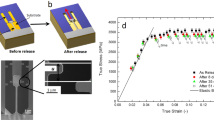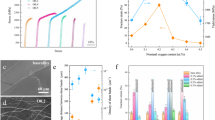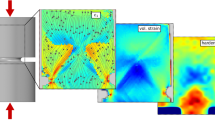Abstract
Amorphous metallic alloys, or metallic glasses, are lucrative engineering materials owing to their superior mechanical properties such as high strength and large elastic strain. However, their main drawback is their propensity for highly catastrophic failure through rapid shear banding, significantly undercutting their structural applications. Here, we show that when reduced to 100 nm, Zr-based metallic glass nanopillars attain ceramic-like strengths (2.25 GPa) and metal-like ductility (25%) simultaneously. We report separate and distinct critical sizes for maximum strength and for the brittle-to-ductile transition, thereby demonstrating that strength and ability to carry plasticity are decoupled at the nanoscale. A phenomenological model for size dependence and brittle-to-homogeneous deformation is provided.
This is a preview of subscription content, access via your institution
Access options
Subscribe to this journal
Receive 12 print issues and online access
$259.00 per year
only $21.58 per issue
Buy this article
- Purchase on Springer Link
- Instant access to full article PDF
Prices may be subject to local taxes which are calculated during checkout





Similar content being viewed by others
References
Greer, J. R., Oliver, W. C. & Nix, W. D. Size dependence of mechanical properties of gold at the micron scale in the absence of strain gradients. Acta Mater. 53, 1821–1830 (2005).
Uchic, M. D., Dimiduk, D. M., Florando, J. N. & Nix, W. D. Sample dimensions influence strength and crystal plasticity. Science 305, 986–989 (2004).
Klement, W., Willens, R. H. & Duwez, P. Non-crystalline structure in solidified gold–silicon alloys. Nature 187, 869–870 (1960).
Ashby, M. F. & Greer, A. L. Metallic glasses as structural materials. Scr. Mater. 54, 321–326 (2006).
Schuh, C. A., Hufnagel, T. C. & Ramamurty, U. Overview no. 144—mechanical behavior of amorphous alloys. Acta Mater. 55, 4067–4109 (2007).
Li, Y. et al. Formation of bulk metallic glasses and their composites. MRS Bull. 32, 624–628 (2007).
Wang, Y. M., Li, J., Hamza, A. V. & Barbee, T. W. Ductile crystalline-amorphous nanolaminates. Proc. Natl Acad. Sci. USA 104, 11155–11160 (2007).
Hofmann, D. C. et al. Designing metallic glass matrix composites with high toughness and tensile ductility. Nature 451, 1085–1089 (2008).
Shan, Z. W. et al. Plastic flow and failure resistance of metallic glass: Insight from in situ compression of nanopillars. Phys. Rev. B 77, 155419 (2008).
Volkert, C. A., Donohue, A. & Spaepen, F. Effect of sample size on deformation in amorphous metals. J. Appl. Phys. 103, 083539 (2008).
Schuster, B. E. et al. Bulk and microscale compressive properties of a Pd-based metallic glass. Scr. Mater. 57, 517–520 (2007).
Schuster, B. E., Wei, Q., Hufnagel, T. C. & Ramesh, K. T. Size-independent strength and deformation mode in compression of a Pd-based metallic glass. Acta Mater. 56, 5091–5100 (2008).
Lai, Y. H. et al. Bulk and microscale compressive behavior of a Zr-based metallic glass. Scr. Mater. 58, 890–893 (2008).
Lee, C. J., Huang, J. C. & Nieh, T. G. Sample size effect and microcompression of Mg65Cu25Gd10 metallic glass. Appl. Phys. Lett. 91, 161913 (2007).
Wu, X. L., Guo, Y. Z., Wei, Q. & Wang, W. H. Prevalence of shear banding in compression of Zr41Ti14Cu12.5Ni10Be22.5 pillars as small as 150 nm in diameter. Acta Mater. 57, 3562–3571 (2009).
Dubach, A., Raghavan, R., Loffler, J. F., Michler, J. & Ramamurty, U. Micropillar compression studies on a bulk metallic glass in different structural states. Scr. Mater. 60, 567–570 (2009).
Chen, C. Q., Pei, Y. T. & De Hosson, J. T. M. Strength of submicrometer diameter pillars of metallic glasses investigated with in situ transmission electron microscopy. Phil. Mag. Lett. 89, 633–640 (2009).
Kiener, D., Motz, C. & Dehm, G. Micro-compression testing: A critical discussion of experimental constraints. Mater. Sci. Eng. A 505, 79–87 (2009).
Ashby, M. F. Materials Selection in Mechanical Design 3rd edn (Elsevier Butterworth-Heinemann, 2005).
Lu, L., Chen, X., Huang, X. & Lu, K. Revealing the maximum strength in nanotwinned copper. Science 323, 607–610 (2009).
Li, Q. K. & Li, M. Molecular dynamics simulation of intrinsic and extrinsic mechanical properties of amorphous metals. Intermetallics 14, 1005–1010 (2006).
Guo, H. et al. Tensile ductility and necking of metallic glass. Nature Mater. 6, 735–739 (2007).
Yokoyama, Y., Fujita, K., Yavari, A. R. & Inoue, A. Malleable hypoeutectic Zr–Ni–Cu–Al bulk glassy alloys with tensile plastic elongation at room temperature. Phil. Mag. Lett. 89, 322–334 (2009).
Courtney, T. H. Mechanical Behavior of Materials 2nd edn (McGraw-Hill, 2000).
Kim, C. P. et al. Fracture toughness study of new Zr-based Be-bearing bulk metallic glasses. Scr. Mater. 60, 80–83 (2009).
Argon, A. S. Plastic deformation in metallic glasses. Acta Metall. 27, 47–58 (1979).
Harmon, J. S., Demetriou, M. D., Johnson, W. L. & Samwer, K. An elastic to plastic transition in metallic glass-forming liquids. Phys. Rev. Lett. 99, 135502 (2007).
Spaepen, F. A microscopic mechanism for steady state inhomogeneous flow in metallic glasses. Acta Metall. 25, 407–415 (1977).
Gao, H. J., Ji, B. H., Jager, I. L., Arzt, E. & Fratzl, P. Materials become insensitive to flaws at nanoscale: Lessons from nature. Proc. Natl Acad. Sci. USA 100, 5597–5600 (2003).
Johnson, W. L. & Samwer, K. A universal criterion for plastic yielding of metallic glasses with a (T/T-g)(2/3) temperature dependence. Phys. Rev. Lett. 95, 195501 (2005).
Acknowledgements
The authors gratefully acknowledge the financial support of the National Science Foundation through MRSEC (DMR-0520565) at Caltech and of the Office of Naval Research (grant no. N000140910883), as well as Kavli Nanoscience Institute at Caltech and W. L. Johnson and M. D. Demetriou for providing the bulk sample and for useful discussions.
Author information
Authors and Affiliations
Contributions
D.J. and J.R.G. designed the research and J.R.G. supervised the project. D.J. carried out the experiments. D.J. and J.R.G. contributed to the interpretation of the results and to the writing of the paper.
Corresponding author
Ethics declarations
Competing interests
The authors declare no competing financial interests.
Rights and permissions
About this article
Cite this article
Jang, D., Greer, J. Transition from a strong-yet-brittle to a stronger-and-ductile state by size reduction of metallic glasses. Nature Mater 9, 215–219 (2010). https://doi.org/10.1038/nmat2622
Received:
Accepted:
Published:
Issue Date:
DOI: https://doi.org/10.1038/nmat2622
This article is cited by
-
Elemental partitioning-mediated crystalline-to-amorphous phase transformation under quasi-static deformation
Nature Communications (2024)
-
Obtaining auxetic and isotropic metamaterials in counterintuitive design spaces: an automated optimization approach and experimental characterization
npj Computational Materials (2024)
-
Machine learning modeling for the prediction of plastic properties in metallic glasses
Scientific Reports (2023)
-
Substantially enhanced homogeneous plastic flow in hierarchically nanodomained amorphous alloys
Nature Communications (2023)
-
Size-dependent deformation behavior in nanosized amorphous metals suggesting transition from collective to individual atomic transport
Nature Communications (2023)



